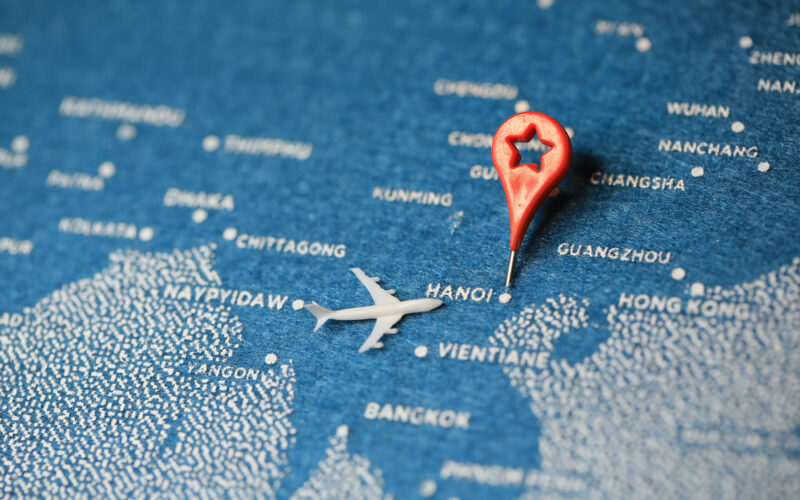While demand for domestic air travel in East and Southeast Asia has shown initial signs of recovery, the International Air Transport Association (IATA) predicts that it will take until 2024 for international air travel across the region to reach pre-pandemic levels.
Even though an extensive vaccination program is being implemented across the region (albeit at different speeds) with various strict air travel restrictions in place, countries are not able to fully recover their domestic and international markets. The IATA forecasts that the challenges posed by the fast-spreading Delta variant and persistent lockdowns may lead countries of the East and Southeast Asia region to a loss of $7.5 billion in 2021.
Domestic recovery slowed down by low vaccination rates
The Association of Asia Pacific Airlines (AAPA) has observed a significant difference between the recovery process across Asia and that of Europe/North America. In its latest report, the trade association outlines that the pace of recovery in different regions depends on the success of the vaccination campaign against the COVID-19 virus. According to the AAPA, the relatively effective vaccination campaigns in Europe and North America have helped their domestic air travel to pick up.
In the meantime, in Asia, particularly in the East and Southeast Asia regions, where the progress in vaccination roll-outs remains slow due to challenges in procuring supplies, domestic air travel shows weak signs of a rebound, while the demand for international operations also shows very little progress.
Due to much slower vaccination rates and new waves of more infectious strains of the virus, governments of various East and Southeast Asian countries are continuing to implement air travel restrictions for domestic and international operations, which slackens the recovery process. The governments would have more options for removing air travel restrictions if countries reached herd immunity vaccination levels of 70% or even higher, analysts from AAPA claim.
However, according to figures from the Center for Strategic and International Studies, which collects the data of vaccination roll-out globally, only China has exceeded the recommended rate of a vaccinated population with 71% of fully vaccinated citizens in the region. Meanwhile, Cambodia, the second most-vaccinated country of the region, has not yet reached the desired 70% (it has vaccinated 68% of people). In the meantime, Malaysia has 63.4% of its population vaccinated.
A completely different picture emerges when looking at vaccination rates in other Asian countries. Brunei has vaccinated just over 40% of its citizens, while other countries of the East and Southeast Asia region, including Laos, Thailand, Philippines, Indonesia, Vietnam, Myanmar, have yet to reach a 30% citizen vaccination rate, the Center for Strategic and International Studies’ data suggests.
The Japanese market is one example of how low vaccination rates and new waves of COVID-19 cases disrupt both domestic and international air travel recovery. According to Japanese government figures, even though the country represents one of the world’s major aviation markets, it has currently vaccinated only 58.9% of its population.
While both the North America and European regions have seen strong demand for air travel during the peak of the 2021 summer season, due to new waves of virus cases in the country, Japan was forced to refrain from easing the existing restrictions. In fact, it had to extend the state of emergency in the country in order to control the spread of the virus. As a result, in June 2021, domestic passenger numbers in Japan dropped to 30% of pre-pandemic levels. To avoid further outbreaks of COVID-19, Japan barred all spectators from the Tokyo Olympics thus losing the opportunity to benefit from the highly anticipated international sports festival.
Indonesia is another Asian country with low vaccination rates. The Indonesia National Air Carriers Association (INACA) predicts that Indonesia, which currently has vaccinated only 18.3% of its people, will recover its domestic and international flight volumes to pre-pandemic levels only in 2024 and 2026 respectively.
However, the INACA says that if the government increases the speed of vaccination, a full domestic recovery could be achieved by December 2022.
As for China, even though air traffic in its domestic market has shown signs of recovery following the end of lockdown in March 2021, the country experienced a repetitive sharp fall in August 2021 when the local government imposed strict domestic travel limitations amid the increasing spread of the virus’s Delta variant. The country, which has already vaccinated more than 70% of its population, was not able to avoid implementing restrictions. The strict air travel policies resulted in less capacity on airlines and therefore a fall in domestic aviation traffic.
Data released by the Civil Aviation Administration of China (CAA) indicates that China’s decision to tighten travel restrictions resulted in just over 22 million domestic passengers carried in August 2021, which was around 52% lower year-on-year. The figure reflected a significant 63% decline in domestic passenger numbers if compared to the same period pre-pandemic.
International operations may recover faster than domestic air travel
Similar recovery trends are notable in international air travel in East and Southeast Asian countries. As COVID-19 cases surge in Japan, Malaysia, Taiwan, Indonesia and the Philippines, as well as elsewhere in the region, the willingness of governments to open up international travel currently remains limited.
The low level of vaccination rates, sudden lockdowns, and inconsistent regulations thwart attempts at recovery. According to the IATA report on the Asia region, the industry-wide revenue passenger kilometers (RPKs) rate across Asia fell by 60.1% in June 2021 compared to pre-pandemic levels, despite the fact that June 2021 was expected to be a key point for future recovery.
IATA predicts that international air travel may recover sooner than expected between the region’s countries given different Covid-19 vaccination rates and continued strict border measures. The association estimates that it will be 2024 before East and Southeast Asia recover, depending on vaccination rates across countries of the region.

